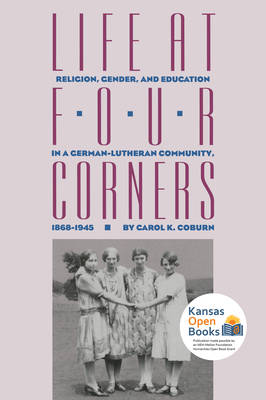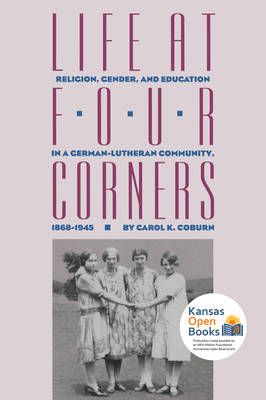
- Afhalen na 1 uur in een winkel met voorraad
- Gratis thuislevering in België vanaf € 30
- Ruim aanbod met 7 miljoen producten
- Afhalen na 1 uur in een winkel met voorraad
- Gratis thuislevering in België vanaf € 30
- Ruim aanbod met 7 miljoen producten
Zoeken
Life at Four Corners
Religion, Gender, and Education in a Germanlutheran Community, 18681945
Carol K Coburn
€ 50,95
+ 101 punten
Omschrijving
Defined less by geography than by demographic character, Block, Kansas, in many ways exemplifies the prevalent yet seldomscrutinized ethnic, religionbased community of the rural midwest. Physically small, the town sprang up around four corners formed by crossroads. Spiritually strong and cohesive, it became the educational and cultural center for generations of GermanLutheran families. Block provided a religious and cultural oasisa welcome transition for GermanLutheran immigrants faced with a new language and unfamiliar customs. Yet the tight bond between an ethnic society and a religion that shunned Americanism and the English language paradoxically slowed the transition and maintained a culturally isolated community well into the twentieth century. In Life at Four Corners, Carol Coburn analyzes the powerful combination of those ethnic and religious institutions that effectively resisted assimilation for nearly 80 years only to succumb to the influences of the outside world during the 1930s and 1940s. Emphasizing the formal and informal education provided by the church, school, and family, she examines the total process of how values, identities, and all aspects of culture were transmitted from generation to generation.
Specificaties
Betrokkenen
- Auteur(s):
- Uitgeverij:
Inhoud
- Aantal bladzijden:
- 244
- Taal:
- Engels
- Reeks:
Eigenschappen
- Productcode (EAN):
- 9780700606825
- Verschijningsdatum:
- 29/10/2021
- Uitvoering:
- Paperback
- Formaat:
- Trade paperback (VS)
- Afmetingen:
- 154 mm x 229 mm
- Gewicht:
- 326 g

Alleen bij Standaard Boekhandel
+ 101 punten op je klantenkaart van Standaard Boekhandel
Beoordelingen
We publiceren alleen reviews die voldoen aan de voorwaarden voor reviews. Bekijk onze voorwaarden voor reviews.











